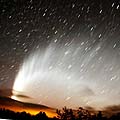
|
Excellent great comet, few times in a lifetime, for southern people. It reached to -5.5 mag on Jan. 14 and 15, brighter than Venus, and visible even in daytime. Then it appeared in the evening sky in the Southern Hemisphere and many people enjoyed a fantastic view of a beautiful great comet, a enormous curving tail with so many striae over 40 degrees. Now it is observable both in the evening and morning. It has already faded down to 4.3 mag (Feb. 8, Alexandre Amorim). It keeps observable almost all night after February until the comet has gone. It will never be observable again in the Northern Hemisphere.
Date(TT) R.A. (2000) Decl. Delta r Elong. m1 Best Time(A, h)
Feb. 10 21 34.37 -56 52.8 1.307 0.880 42 4.4 19:02 ( 41,-35)
Feb. 17 21 51.37 -59 13.4 1.418 1.038 47 5.5 5:19 (322,-35)
|
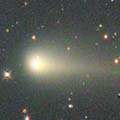
|
It reached up to 9.3 mag between October and November (Oct. 27, Juan Jose Gonzalez). It had been observable in excellent condition. But it is fading now. It has already faded down to 11.7 mag (Feb. 4, Juan Jose Gonzalez). However, it keeps observable after this until May when it fades down to 16 mag. It will keep visible visually until around March.
Date(TT) R.A. (2000) Decl. Delta r Elong. m1 Best Time(A, h)
Feb. 10 3 52.67 9 7.1 1.474 1.872 97 12.4 19:02 ( 16, 63)
Feb. 17 4 5.97 10 6.0 1.567 1.903 93 12.7 19:08 ( 27, 63)
|
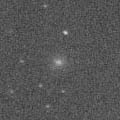
|
First return of a new bright periodic comet observed at 9 mag in 2001. It is brightening very rapidly. It was 16.1 mag on Jan. 11 (Filip Fratev), but it brightened up to 12.0-12.5 mag on Feb. 9 (Michael Jager). Fainter than expected by 1.5 mag, but unexpectedly, it is brightening to be visible visually. However, the condition of this apparition is bad. It keeps locating very low in the evening until early May. It reaches to 12.5 mag at best, and it will start fading after mid March.
Date(TT) R.A. (2000) Decl. Delta r Elong. m1 Best Time(A, h)
Feb. 10 23 12.35 -2 28.3 1.724 0.962 27 12.8 19:02 ( 81, 9)
Feb. 17 23 43.41 -0 30.8 1.692 0.944 28 12.5 19:08 ( 83, 10)
|
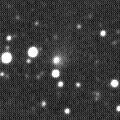
|
Now it is 12.2 mag (Dec. 28, Juan Jose Gonzalez). It keeps 12-13 mag until March and visible visually.
Date(TT) R.A. (2000) Decl. Delta r Elong. m1 Best Time(A, h)
Feb. 10 18 51.31 51 36.0 2.268 2.225 74 12.8 5:26 (229, 44)
Feb. 17 19 18.29 55 46.0 2.290 2.263 75 12.8 5:19 (223, 43)
|
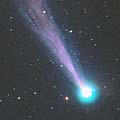
|
It suddenly brightened in outburst on Oct. 24, and reached up to 4.2 mag on Oct. 25 (Maik Meyer). But it had faded down to 10.5 mag on Jan. 11 (Carlos Labordena). Now it is not observable. It will appear in the morning sky again at 15-16 mag in May. Then it keeps observable until it becomes fainter than 18 mag in autumn.
Date(TT) R.A. (2000) Decl. Delta r Elong. m1 Best Time(A, h)
Feb. 10 21 55.14 -7 7.1 3.318 2.349 9 13.2 19:02 ( 88,-10)
Feb. 17 22 2.99 -7 25.4 3.423 2.440 4 13.4 19:08 ( 91,-15)
|

|
In this season, it has been bright as 12-13 mag and visible visually since it appeared in the morning sky in early July. Another outburst occurred on Jan. 29 and it reached to 13 mag on CCD images (Albert Sanchez Caso). It keeps observable in good condition until March.
Date(TT) R.A. (2000) Decl. Delta r Elong. m1 Best Time(A, h)
Feb. 10 3 45.02 28 45.9 5.636 5.882 99 13.5 19:02 ( 54, 80)
Feb. 17 3 46.79 28 38.3 5.749 5.884 92 13.6 19:08 ( 71, 74)
|
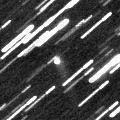
|
Now it is 14.1 mag (Jan. 15, Maciej Reszelski). Almost asteroidal. It did not brighten at all since early September. Although the slight cometary activity was detected in late July, it became completely stellar soon. Its tail became visible again in late October, however, it turned to be stellar again soon. Finally it has passed the perihelion, keeping almost asteroidal. In the Northern Hemisphere, it keeps good condition after this. It keeps locating high until spring. It is fainter than this ephemeris recently.
Date(TT) R.A. (2000) Decl. Delta r Elong. m1 Best Time(A, h)
Feb. 10 3 16.21 42 29.5 0.801 1.343 96 13.8 19:02 (125, 76)
Feb. 17 3 59.25 39 0.9 0.850 1.385 97 14.0 19:08 (113, 79)
|
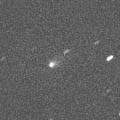
|
It was visible visually on Oct. 31 at 13.7 mag (Seiichi Yoshida). It was still bright as 13.8 mag at the end of 2006 (Dec. 29, Katsumi Yoshimoto). It keeps 13-14 mag until March. It is observable in good condition in the Southern Hemisphere, although it is already not observable in the Northern Hemisphere.
Date(TT) R.A. (2000) Decl. Delta r Elong. m1 Best Time(A, h)
Feb. 10 14 53.00 -61 37.8 2.042 2.138 81 13.8 5:26 (359, -7)
Feb. 17 15 11.36 -63 50.7 2.031 2.169 84 13.9 5:19 (359, -9)
|
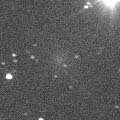
|
It will reach to 6 mag at the perihelion passage in mid April. It has already started brightening very rapidly. How it is 14.0 mag (Feb. 9, Michael Jager). It is observale while brightening gradually in the evening sky in the Northern Hemisphere. However, it will locate very low when it is bright enough to see visually. It will be lower than 20 degree soon. It will be 11.5 mag in mid March, when the altitude becomes lower than 10 degree. After conjunction with the sun, it appears in the morning sky at 12 mag in June. But it locates only 20 degree high at most, and it will be fading rapidly. In the Southern Hemisphere, it appears in the morning sky at 8 mag in May, then it will be bright and observable for a while.
Date(TT) R.A. (2000) Decl. Delta r Elong. m1 Best Time(A, h)
Feb. 10 23 55.76 7 1.6 1.970 1.395 41 14.9 19:02 ( 82, 23)
Feb. 17 0 7.81 8 11.8 1.926 1.295 37 14.0 19:08 ( 86, 20)
|
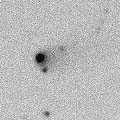
|
It has been visible at 13.5 mag for a long time since 2005 autumn until 2006 spring. Now it is fainter than last year by 1 mag, however, it is still visible visually at 14.2 mag (Dec. 22, Seiichi Yoshida). It keeps observable in excellent condition until April.
Date(TT) R.A. (2000) Decl. Delta r Elong. m1 Best Time(A, h)
Feb. 10 13 13.49 23 1.9 5.020 5.673 127 14.4 3:55 ( 0, 78)
Feb. 17 13 12.43 23 17.3 4.973 5.694 133 14.4 3:27 ( 0, 78)
|
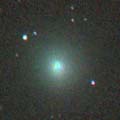
|
When it approached to the earth between from November to early December, it reached up to 8.5 mag as a very large diffuse object with a diameter larger than 10 arcmin (Nov. 23, Peter Bus). However, now it is fading rapidly. It has already faded down to 12.2 mag (Jan. 20, Carlos Labordena). It will be fainter than 14 mag, too faint to see visually, in February. It will set down in the evening sky at 17 mag in March.
Date(TT) R.A. (2000) Decl. Delta r Elong. m1 Best Time(A, h)
Feb. 10 1 17.55 35 29.4 2.215 2.145 73 14.5 19:02 (105, 53)
Feb. 17 1 17.31 34 57.8 2.414 2.211 66 15.1 19:08 (106, 46)
|

|
It is observable in good condition in the Southern Hemisphere. But it had been unobservable before January in the Northern Hemisphere. It was discovered at 17.5 mag in May. Then it has not been brightening well. It is 16.5-17 mag still in December. It will be observable also in the Northern Hemisphere in the evening low sky from January to March, however, it will be fainter than 15 mag.
Date(TT) R.A. (2000) Decl. Delta r Elong. m1 Best Time(A, h)
Feb. 10 2 28.60 -27 28.8 2.698 2.525 69 15.2 19:02 ( 27, 22)
Feb. 17 2 29.29 -23 31.8 2.777 2.515 64 15.2 19:08 ( 36, 22)
|
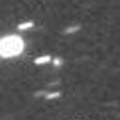
|
Although it had been unobservable since last autumn, now it is appearing again in the morning sky. It will be observable at 14.5 mag from spring to summer both in 2007 and 2008. The condition is good, and it may be visible visually.
Date(TT) R.A. (2000) Decl. Delta r Elong. m1 Best Time(A, h)
Feb. 10 18 58.00 -15 4.7 6.862 6.107 37 15.6 5:26 (298, 12)
Feb. 17 18 59.42 -14 35.5 6.760 6.087 43 15.6 5:19 (301, 16)
|
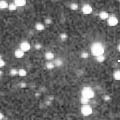
|
Now it is 15.9 mag (Jan. 10, Ken-ichi Kadota). It keeps observable at 15 mag in the evening sky until May. It is not observable around the perihelion passage in conjunction with the sun. Then it moves to the southern sky, and it will be unobservable in the Northern Hemisphere.
Date(TT) R.A. (2000) Decl. Delta r Elong. m1 Best Time(A, h)
Feb. 10 2 52.14 47 59.8 2.421 2.680 94 15.7 19:02 (135, 69)
Feb. 17 3 1.99 46 56.8 2.440 2.621 89 15.6 19:08 (128, 66)
|

|
Now it is 15.3 mag (Jan. 7, Ken-ichi Kadota). It is observable at 15.5-16 mag until spring. But, in the Northern Hemisphere, it locates somewhat low at 20-30 degree high.
Date(TT) R.A. (2000) Decl. Delta r Elong. m1 Best Time(A, h)
Feb. 10 5 16.01 -31 25.4 3.546 3.892 103 15.7 19:55 ( 0, 24)
Feb. 17 5 5.93 -30 10.0 3.632 3.889 97 15.7 19:17 ( 0, 25)
|

|
Now it is 16.3 mag (Jan. 9, Mitsunori Tsumura). It will reach to 11 mag in 2008 spring. It keeps moving in the southern sky until that, so it keeps locating very low in the Northern Hemisphere. It keeps observable in good condition in the Southern Hemisphere. In the Northern Hemisphere, it is observable at 16 mag in the evening low sky until March, then it will be unobservable. It will be observable again in a short time in the very low sky at dawn in November at 13 mag. After 2008 March, it will be visible visually at 11 mag in the morning low sky.
Date(TT) R.A. (2000) Decl. Delta r Elong. m1 Best Time(A, h)
Feb. 10 4 49.85 -36 47.3 5.381 5.573 96 15.9 19:29 ( 0, 18)
Feb. 17 4 49.58 -36 3.0 5.388 5.521 92 15.9 19:08 ( 1, 19)
|

|
It will be brightening gradually at the high altitude until 2007 spring, while it brightens up to 16 mag. Then it keeps 15.5-16 mag for one year and a half until 2008 summer. However, because the comet moves southwards, it is only observable until 2007 June in the Northern Hemisphere.
Date(TT) R.A. (2000) Decl. Delta r Elong. m1 Best Time(A, h)
Feb. 10 11 0.57 3 28.3 3.031 3.951 155 16.6 1:43 ( 0, 58)
Feb. 17 10 55.92 3 8.5 2.945 3.903 163 16.5 1:11 ( 0, 58)
|
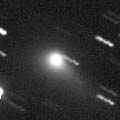
|
It was still visible visually at 14.2 mag on Oct. 31 (Seiichi Yoshida). However, it has already faded down to 16.3 mag (Jan. 30, Ken-ichi Kadota). It keeps a good contition until spring, while the comet will be fading gradually.
Date(TT) R.A. (2000) Decl. Delta r Elong. m1 Best Time(A, h)
Feb. 10 9 30.76 26 36.5 3.482 4.452 167 16.5 0:14 ( 0, 82)
Feb. 17 9 25.29 26 43.2 3.562 4.517 163 16.6 23:36 ( 0, 82)
|
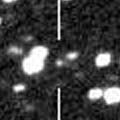
|
It tends to become brightest about 4 months after the perihelion passage. In this apparition, it was 17.6 mag in late July around the perihelion passage (July 23, Filip Fratev), however, it brightened up to 14.1 mag and became visible visually on Dec. 23 (Seiichi Yoshida). But it will start fading after this. Although it keeps a good condition for a long time, it will be fainter than 18 mag in March.
Date(TT) R.A. (2000) Decl. Delta r Elong. m1 Best Time(A, h)
Feb. 10 5 25.39 21 25.5 1.761 2.424 121 16.9 20:05 ( 0, 76)
Feb. 17 5 29.32 21 52.4 1.871 2.458 115 17.1 19:41 ( 0, 77)
|

|
Now it is 16.8 mag (Dec. 29, Katsumi Yoshimoto). It is outside of Jupiter's orbit. So it keeps 17 mag for a long time until 2007 summer. It keeps locating high and observable in good condition for a long time after this because it moves in the northern sky.
Date(TT) R.A. (2000) Decl. Delta r Elong. m1 Best Time(A, h)
Feb. 10 14 49.89 38 52.8 6.844 7.200 107 17.1 5:26 (196, 86)
Feb. 17 14 48.75 39 13.8 6.795 7.215 111 17.1 5:03 (180, 86)
|

|
It reached to 16.5 mag at best in December and January. But now it is already fading. It will be fainer than 18 mag in April.
Date(TT) R.A. (2000) Decl. Delta r Elong. m1 Best Time(A, h)
Feb. 10 6 9.13 28 21.9 1.560 2.331 131 17.1 20:48 ( 0, 83)
Feb. 17 6 10.92 28 6.2 1.628 2.334 124 17.2 20:23 ( 0, 83)
|
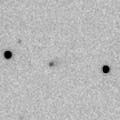
|
It reached to 16 mag in early 2006. Now it is 17.3 mag (Dec. 2, Ken-ichi Kadota). It will be fading very slowly from 17 mag to 18 mag until 2007 summer. In the Northern Hemisphere, it keeps locating high.
Date(TT) R.A. (2000) Decl. Delta r Elong. m1 Best Time(A, h)
Feb. 10 14 24.21 32 18.1 5.253 5.697 112 17.2 5:06 ( 0, 87)
Feb. 17 14 24.20 32 41.8 5.210 5.722 116 17.2 4:38 ( 0, 88)
|
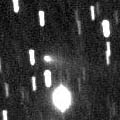
|
It was expected to reach to 13 mag in winter. But actually, it was 15.7 mag at best (Dec. 5, Ken-ichi Kadota), much fainter than expected. It will fade out rapidly after this. It will be fainter than 18 mag soon.
Date(TT) R.A. (2000) Decl. Delta r Elong. m1 Best Time(A, h)
Feb. 10 7 49.81 62 33.1 1.003 1.794 128 17.3 22:29 (180, 62)
Feb. 17 7 49.48 62 40.4 1.073 1.824 124 17.6 22:01 (180, 62)
|
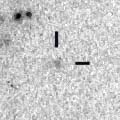
|
It was observed at 17.5 mag in 2006 spring. It will be observable at 17 mag in good condition in 2007 spring.
Date(TT) R.A. (2000) Decl. Delta r Elong. m1 Best Time(A, h)
Feb. 10 14 13.58 -13 1.9 4.364 4.719 105 17.4 4:55 ( 0, 42)
Feb. 17 14 14.66 -13 10.9 4.260 4.720 111 17.3 4:29 ( 0, 42)
|
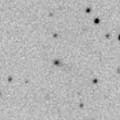
|
Now it is 16.8 mag (Jan. 9, Mitsunori Tsumura). The perihelion passage is in 2008. It will be observable for several years after this at around 17 mag. But it may fade out rapidly just after the perihelion passage.
Date(TT) R.A. (2000) Decl. Delta r Elong. m1 Best Time(A, h)
Feb. 10 4 12.67 13 25.1 4.312 4.632 102 17.3 19:02 ( 6, 68)
Feb. 17 4 14.14 13 52.5 4.407 4.621 96 17.4 19:08 ( 27, 67)
|
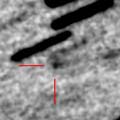
|
It was observed at 19 mag in mid December. It will reach to 17 mag in spring, and will be observable in good condition.
Date(TT) R.A. (2000) Decl. Delta r Elong. m1 Best Time(A, h)
Feb. 10 11 11.37 3 16.6 1.482 2.404 153 17.6 1:54 ( 0, 58)
Feb. 17 11 8.18 3 42.6 1.428 2.385 161 17.4 1:23 ( 0, 59)
|
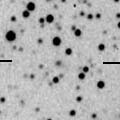
|
It has been observed in good condition at 17 mag. But it will be fading after this, and it becomes fainter than 18 mag in April. It will be observable in good condition at 18 mag again one year later.
Date(TT) R.A. (2000) Decl. Delta r Elong. m1 Best Time(A, h)
Feb. 10 4 4.38 48 12.7 3.426 3.818 106 17.5 19:02 (167, 76)
Feb. 17 4 8.94 47 42.1 3.513 3.819 100 17.5 19:08 (149, 75)
|

|
It was visible visually at 12 mag in last spring. Now it is 17.2 mag (Dec. 29, Katsumi Yoshimoto). It will keep good condition for a while after this, but it will be fading gradually.
Date(TT) R.A. (2000) Decl. Delta r Elong. m1 Best Time(A, h)
Feb. 10 16 54.11 40 28.9 4.558 4.574 84 17.8 5:26 (248, 64)
Feb. 17 16 55.06 42 20.4 4.560 4.638 88 17.9 5:19 (243, 68)
|

|
It had been lost since its discovery in 1986. But it was rediscovered on Jan. 9 at 16-17 mag. The condition is good in this return, and it was expected to reach to 14 mag from autumn to winter. But actually, it is fainter than originally expected, and it seems to have reached to 17 mag at best. It will be fainter than 18 mag in February.
Date(TT) R.A. (2000) Decl. Delta r Elong. m1 Best Time(A, h)
Feb. 10 0 32.21 4 36.3 2.012 1.545 48 17.9 19:02 ( 74, 29)
Feb. 17 0 52.92 6 43.9 2.079 1.579 46 18.1 19:08 ( 78, 28)
|

|
Now it is around the aphelion and faintest, but it is observed at 18 mag. It will be observable at 18 mag in good condition until March. It will be 13-14 mag and visible visually again in 2009. It will reach to 12.5 mag in 2010. But in the Northern Hemisphere, it will locate very low in the south at that time.
Date(TT) R.A. (2000) Decl. Delta r Elong. m1 Best Time(A, h)
Feb. 10 5 34.48 28 37.1 4.087 4.703 123 17.9 20:14 ( 0, 84)
Feb. 17 5 33.34 28 35.2 4.179 4.700 116 18.0 19:45 ( 0, 84)
|

|
It was in major outburst unexpectedly and reached to 10.5 mag in its last appearance in 1999. However, it is faint in this apparition. Now it is 17.4 mag (Nov. 23, Ken-ichi Kadota). It will fade out gradually after this.
Date(TT) R.A. (2000) Decl. Delta r Elong. m1 Best Time(A, h)
Feb. 10 14 0.22 -19 54.3 1.922 2.386 105 18.5 4:42 ( 0, 35)
Feb. 17 14 1.89 -20 45.9 1.874 2.425 112 18.6 4:16 ( 0, 34)
|
|
![]()
 C/2005 L3 ( McNaught )
C/2005 L3 ( McNaught ) C/2006 XA1 ( LINEAR )
C/2006 XA1 ( LINEAR ) C/2005 EL173 ( LONEOS )
C/2005 EL173 ( LONEOS ) C/2006 Q1 ( McNaught )
C/2006 Q1 ( McNaught ) C/2006 V1 ( Catalina )
C/2006 V1 ( Catalina ) C/2005 E2 ( McNaught )
C/2005 E2 ( McNaught ) 84P/Giclas
84P/Giclas C/2002 VQ94 ( LINEAR )
C/2002 VQ94 ( LINEAR ) P/2006 U5 ( Christensen )
P/2006 U5 ( Christensen ) C/2004 D1 ( NEAT )
C/2004 D1 ( NEAT ) 76P/West-Kohoutek-Ikemura
76P/West-Kohoutek-Ikemura 99P/Kowal 1
99P/Kowal 1 173P/2005 T1 ( Mueller 5 )
173P/2005 T1 ( Mueller 5 ) 87P/Bus
87P/Bus P/2005 SB216 ( LONEOS )
P/2005 SB216 ( LONEOS ) C/2004 B1 ( LINEAR )
C/2004 B1 ( LINEAR ) 184P/2007 A1 ( Lovas 2 )
184P/2007 A1 ( Lovas 2 ) 65P/Gunn
65P/Gunn 52P/Harrington-Abell
52P/Harrington-Abell![]()






















